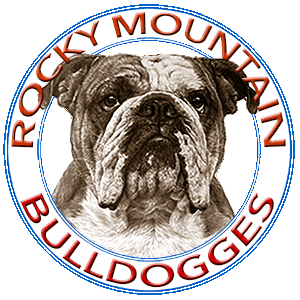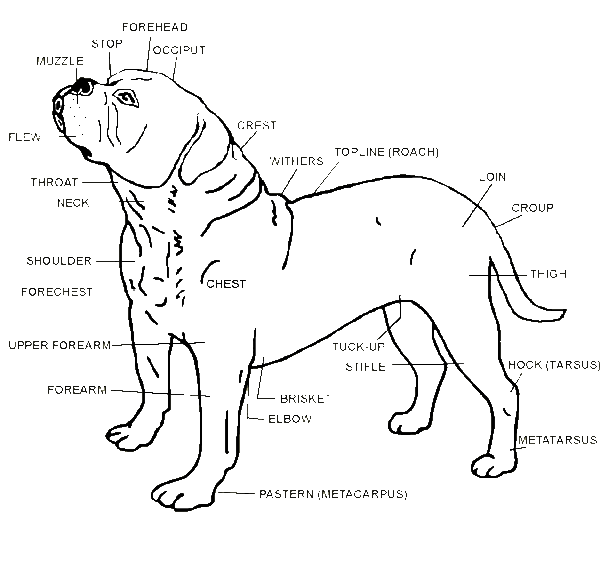
Olde English Bulldogge
breed Standards reconized by the UKC and the LBA
GENERAL APPEARANCE
The Olde English Bulldogge is a muscular, medium sized dog of great strength, and possessed of fluid, agile movement. He is well balanced and proportioned, while appearing capable of performing without any breathing restrictions in either heat or in cold.
Disqualifications: Unilateral or bilateral cryptorchid.
CHARACTERISTICS
The disposition of the Olde English Bulldogge is confident, friendly and alert. An OEB should be an animated and expressive dog, both in and out of the show ring.
Fault: Shyness in a mature dog.
Disqualification: Viciousness or extreme shyness.
We are Rocky Mountain Bulldogges, located at 7380 Idaho Lane, Colorado Springs, Colorado 80923. Phone number 719-229-6611
We are proud breeders of authentic Olde English Bulldogges. Our dogs are all purebred with registration in the United Kennel Club. We are registered breeders with the Olde English Bulldogge Kennel Club, the recognized parent club of the breed.
We breed only the David Leavitt blood line of the Olde English Bulldooge. This foundational Olde English Bulldogge breed is traditionally the most healthiest of all the bulldogge breeds. The olde english bulldogge breed typically lives up to 14 years.
We go to great measures to insure the UKC registration and DNA qualifications for our breeding program are of the highest standards.
It is well documented that the Olde English Bulldogge was created in the early 1970’s by David Leavitt. Therefore, to be a true Olde English Bulldogge the pedigree of any particular dog must be traceable back to the Leavitt foundation stock without any unapproved outcrosses in the lines. It’s really quite simple. We’re not saying that just because the alternative bulldogs can’t be traced back to the foundation stock that they are bad bulldogs. We’re saying that they aren’t Olde English Bulldogges. The Olde English Bulldogge name has been used fraudulently for some time now. The reputable breeders of alternative bulldogs, many of whom have created some very nice dogs, realized that they shouldn’t be using a name that doesn’t belong to them or that doesn’t apply to their dogs and then had the integrity to use a different name. These breeders were also proud enough of their creations that they wanted to assign their own unique breed name. Unfortunately there are many more breeders that continue to use the name Olde English Bulldogge fraudulently simply because it helps them sell puppies. They have accepted the fact that they falsely use the name.
Luckily you have found the home of the true authentic Olde English Bulldogge
TEETH - Bite is undershot or reverse scissors. Lower jawbone is moderately curved from front to back. Broken, chipped or extracted teeth are not to be faulted. Exposed canine teeth are to be faulted.
Disqualifications: Wry jaw; overbite.
NOSE - Nostrils are wide, with a line running vertically between nostrils from the tip of nose down to the bottom of the upper lip. Nose is large and broad in relationship to the width of the muzzle. Nose color is black.
Serious Fault: Slit nostrils.
Disqualification: Any color nose other than black.
EYES - Eyes are medium in size and almond shaped. They are set wide and low, level with the top of the muzzle. Color is dark to light brown, with black pigmented eye rims.
Disqualifications: Any eye color other than brown; wall eyes; crossed eyes.
EARS - Ears are rose, button or tulip. Rose is preferred. They are set high, wide and to the back outer edge of the skull. The ears are small in size.
NECK
The neck is medium length, wide, and slightly arched. It is slightly smaller than the head at their junction, and widens to point of the shoulders. Loose from jaw to chest, forming a double dewlap.
FOREQUARTERS
Shoulders are broad, heavily muscled and have a separation between the shoulder blades. Moderate angulation of the shoulder blade, which should also be roughly equal in length to the upper foreleg.
ELBOWS - Elbows should be neither in nor out.
FORELEGS - Forelegs are of medium bone, set straight, with strong pasterns.
BODY
Sturdy, powerful and slightly rectangular when viewed from the side. Chest is wide and deep, with a muscular brisket, and ribs well-sprung. There should be a distinct tuck between ribs and hindquarters. There is a dip behind the whithers; topline rises over the loin with the appearance of a slight roach.
Faults: Narrow rib cage.
HINDQUARTERS
Hind legs are well muscled and have the appearance of being slightly longer than the forelegs.
Viewed from the rear, the hind legs should be straight, parallel and set apart. Angulation is moderate.
Fault: Cow-hocked or bow-hocked.
FEET
Feet are strong and rounded, with well-arched toes.
Faults: Flat feet or splayed toes.
TAIL
A full tail is preferred. The characteristic tail is often referred to as a crank or pump handle tail. Straight tails are also acceptable. The tail is set on as a natural extension of the topline, and tapers to a point. When the dog is relaxed, the tail is carried low and extends approximately to the hock. When the dog is moving, the tail is carried level with the backline. When the dog is excited, the tail may be carried in a raised, upright position (challenge tail), but never curled over the back (gay tail). A docked tail is acceptable, but not preferred.
Faults: Tail curling 360 degrees or carried up over the back.
Disqualifications: Natural bob tail. Screw tail. Kinked tail (a tail with one or more sharp bends).
COAT
Coat is short, close and of medium density. It should be shiny, showing good health.
Faults: Fringe, feather or curl in the coat.
COLOR
Accepted color patterns include brindle, and solid colors, with or without white.
Brindle is defined as a fine streaked or striped effect or pattern of black or tan hairs with hairs of a lighter or darker background color. Shades of colors accepted include red brindle, fawn brindle, brown brindle, and grey brindle; either solid or pied.
Accepted solid colors include white, fawn or red; with or without white.
Disqualifications: Albinism. Blue, black, and black with rust/mahogany/tan trim.
GAIT
At a trot, the gait is smooth, powerful, energetic and confident. A slight roll to the gait should not be faulted. Footfalls approach the centerline as trotting speed increases.
When viewed from the front or rear, the legs turn neither in nor out, nor do feet cross or interfere with each other. From the side, the front legs should reach out smoothly with no obvious pounding.
HEIGHT AND WEIGHT
Overall balance is never to be sacrificed in favor of size.
Male dogs should be 60 to 80 pounds, and 17 to 20 inches at the withers.
Bitches should be 50 to 70 pounds, and 16 to 19 inches at the withers.
Neither dog nor bitch appears fat. Measurements apply at age 2 or older. Weight of both dog and bitch should be proportionate to height.
DISQUALIFICATIONS
(A dog with a Disqualifications must not be considered for placement in a conformation event, and must be reported to UKC.)
Unilateral or bilateral cryptorchid.
Viciousness or extreme shyness.
Albinism.
Wry jaw.
Overbite.
Any color nose other than black.
Any eye color other than brown.
Wall eyes.
Crossed eyes.
Natural bob tail.
Screw tail.
Kinked tail (a tail with one or more sharp bends)
Blue, black, and black with rust or mahogany.
The docking of tails and cropping of ears in America is legal and remains a personal choice. However, as an international registry, the United Kennel Club, Inc. is aware that the practices of cropping and docking have been forbidden in some countries. In light of these developments, the United Kennel Club, Inc. feels that no dog in any UKC event, including conformation, shall be penalized for a full tail or natural ears.

HEAD
Serious Faults: Excessive wrinkle, lack of pigment around eyes, nose or mouth.
SKULL – The skull is large and well-proportioned to the dog’s muscular body and prominent shoulders. There is a defined furrow from the stop to the occiput.
Serious Faults: Narrow skull; domed forehead.
MUZZLE – The muzzle appears square, wide and deep, with definite layback. Distance from the tip of the nose to the stop does not exceed one-third of the distance from the tip of the nose to the occiput. Flews are semi-pendulous.
